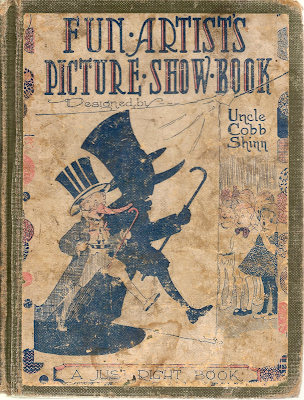Roy W. Taylor (1876-1914)
Originally posted Oct. 2010
Early newspaper comics were everything that comics today are not: big, adventurous, innovative, violent, and politically incorrect. For every ethnic group, there was a comic strip that poked fun and perhaps helped ease relations among the myriad groups poured into the American melting pot. The Katzenjammer Kids (1897) was an early example, one of the earliest in fact. In our hypersensitive age, the Captain or Hans and Fritz's Mamma, with their plump bodies and comical accents, could be taken as unfair stereotypes. Or you can look at them as just plain funny.
Pioneering cartoonist Roy W. Taylor made his own contribution to ethnic comic strips with Yens Yansen Yanitor, a Sunday page drawn for the New York World between 1906 and 1912. The title character is a skinny Scandinavian with a bushy mustache and a clay pipe. The example here plays like an episode of Happy Hooligan as Yens' scheme falls apart and he is hauled away by a policeman. In a mere six panels, the cartoonist fits in three ethnic characters, two of which, the Italian organ grinder and the Irish cop, are drawn from stock.
Roy W. Taylor was born in Nov. 1876 into a Richmond, Indiana, family. Little is known about his early life, but during the first part of the twentieth century, he cartooned for the Chicago Daily News, the New York World, and the Philadelphia North American. His earliest known comic strip was Brainy Bowers, which began appearing in the Chicago Daily News in about 1901. Taylor was succeeded on that strip by Ed Carey (1870-1918), one of the most popular and prolific cartoonists of his day. By the time Taylor gave up Brainy Bowers, he had already started Yens Yensen Yanitor. Three other short-run strips for the New York World followed: Mrs. Firstlove (1908), Mr. Meanto (1910-1911), and Uncle Mose (1911-1912). Yens Yensen outlasted them all and came to an end in Sept. 1912.
Towards the end of his career, Taylor made the move to the Philadelphia North American. He soon fell ill with Bright's disease. Nearing death, he was taken to his mother's house in Washington, D.C., where he died at age thirty-six, on Oct. 20, 1914. His body was delivered to Richmond for burial.
You can see pictures of Brainy Bowers on a blog called Yesterday's Papers, here.
 |
| Yens Yensen Yanitor was one of Hoosier cartoonist Roy W. Taylor's entries in the long list of ethnic comic strips of his day. The date for this episode is unknown, but Yens Yensen ran in the New York World from 1906 to 1912. |
Text and captions copyright 2011, 2024 by Terence E. Hanley












